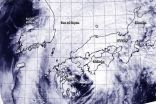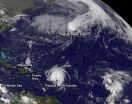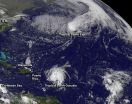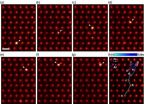(Press-News.org) The climate is getting warmer, the ice sheets are melting and sea levels are rising – but how much? The report of the UN's Intergovernmental Panel on Climate Change (IPCC) in 2013 was based on the best available estimates of future sea levels, but the panel was not able to come up with an upper limit for sea level rise within this century. Now researchers from the Niels Bohr Institute and their colleagues have calculated the risk for a worst-case scenario. The results indicate that at worst, the sea level would rise a maximum of 1.8 meters. The results are published in the scientific journal Environmental Research Letters.
What causes the sea to rise is when all the water that is now frozen as ice and lies on land melts and flows into the sea. It is first and foremost about the two large, kilometer-thick ice sheets on Greenland and Antarctica, but also mountain glaciers. In addition, large amounts of groundwater is pumped for both drinking water and agricultural use in many parts of the world and more groundwater is pumped than seeps back down into the ground, so this water also ends up in the oceans. Finally, what happens is that when the climate gets warmer, the oceans also get warmer and hot water expands and takes up more space. But how much do the experts expect the sea levels to rise during this century at the maximum?
Melting of the ice sheets
"We wanted to try to calculate an upper limit for the rise in sea level and the biggest question is the melting of the ice sheets and how quickly this will happen. The IPCC restricted their projektions to only using results based on models of each process that contributes to sea level. But the greatest uncertainty in assessing the evolution of sea levels is that ice sheet models have only a limited ability to capture the key driving forces in the dynamics of the ice sheets in relation to climatic impact," Aslak Grinsted, Associate Professor at the Centre for Ice and Climate at the Niels Bohr Institute at the University of Copenhagen.
Aslak Grinsted has therefore, in collaboration with researchers from England and China, worked out new calculations. The researchers have combined the IPCC numbers with published data about the expectations within the ice-sheet expert community for the evolution, including the risk for the collapse of parts of Antarctica and how quickly such a collapse would take place.
"We have created a picture of the propable limits for how much global sea levels will rise in this century. Our calculations show that the seas will likely rise around 80 cm. An increase of more than 180 cm has a likelihood of less than 5 percent. We find that a rise in sea levels of more than 2 meters is improbable," Aslak Grinsted, but points that the results only concern this century and the sea levels will continue to rise for centuries to come.
INFORMATION:
Article in Environmental Research Letters: http://iopscience.iop.org/1748-9326/9/10/104008
For more information contact:
Aslak Grinsted, Associate Professor at the Centre for Ice and Climate at the Niels Bohr Institute at the University of Copenhagen, Mobile: +45 3138-0716, aslak@nbi.ku.dk
Svetlana Jevrejeva, National Oceanography Centre, UK,
Tel: +44 (0) 151 795 4800, sveta@noc.ac.uk
Rising sea levels of 1.8 meters in worst-case scenario
2014-10-14
ELSE PRESS RELEASES FROM THIS DATE:
The chemistry of pizza (video)
2014-10-14
WASHINGTON, Oct. 13, 2014 — Whether it's a plain cheese, a deep-dish stacked with meats or a thin-crust veggie delight, there's just something about pizza that makes it delicious. There's a lot of chemistry that goes into everything from dough to sauce to toppings to, of course, cheese. There's also a very specific chemical reaction at work on every single slice, no matter what toppings you choose. Check out the latest episode here: http://youtu.be/tOkCgAwhh9U.
Subscribe to the series at Reactions YouTube, and follow us on Twitter @ACSreactions to be the first to ...
Oral drug reduces formation of precancerous polyps in the colon, UB researchers find
2014-10-14
BUFFALO, N.Y. — An oral biologic medication has successfully treated chronic, precancerous inflammation in the intestine, according to results of an animal study authored by an MD/PhD student in the University at Buffalo School of Medicine and Biomedical Sciences.
The study is featured on the cover of the current issue of Cancer Research; it was published online ahead of print in September. The journal's editors characterized the study's findings as "striking."
Inflammatory cells in the colon, or polyps, are very common after the age of 50. The average 60-year-old ...
NASA satellite sees wind shear affecting Tropical Storm Vongfong
2014-10-14
Tropical Storm Vongfong continues to weaken as it tracks across the big islands of Japan, and NASA satellite data showed that westerly wind shear is taking its toll on the storm's structure.
On Oct. 12 at 0500 UTC (1 a.m. EDT), the MODIS instrument aboard NASA's Aqua satellite captured an image of Tropical Storm Vongfong approaching Japan. Despite weakening to a tropical storm, Vongfong still appeared to have an eye as its northeastern quadrant blanketed the large island of Kyushu, Japan. By 11 a.m. EDT, Maximum sustained winds had dropped to 55 knots (63 mph/102 kph). ...
Tropical Storm Gonzalo triggered many warnings in Eastern Caribbean
2014-10-14
The Eastern Caribbean islands were getting the brunt of Tropical Storm Gonzalo as the storm slowly moved through on Oct. 13. NASA's Terra satellite and NOAA's GOES-East satellite provided data on the storm. Gonzalo is the sixth named storm in the Atlantic Ocean Hurricane Season.
On Oct. 12 at 15:00 UTC (11:00 a.m. EDT), NASA's Terra satellite flew over Tropical Storm Gonzalo while it moved over the Lesser Antilles. The MODIS instrument captured a visible image of the storm that showed a concentration of strong thunderstorms around the center of circulation and in a thick ...
Satellites confirm Fay weakened to a Tropical Storm
2014-10-14
The fifth named Atlantic storm didn't maintain hurricane status long. Fay became a hurricane late on Oct. 12 and by early on Oct. 13, had weakened back to a tropical storm.
A visible image from NOAA's GOES-East satellite on Oct. 13 at 1145 UTC (7:45 a.m. EDT) showed Tropical Storm Fay northeast of Bermuda and Tropical Storm Gonzalo over the Lesser Antilles. Fay appeared circular, but didn't have the signature shape of a tropical storm like Gonzalo, with bands of thunderstorms spiraling into the center. The image was created by the NASA/NOAA GOES Project at NASA's Goddard ...
ORNL researchers make first observation of atoms moving inside bulk material
2014-10-14
OAK RIDGE, Tenn., Oct. 13, 2014 -- Researchers at the Department of Energy's Oak Ridge National Laboratory have obtained the first direct observations of atomic diffusion inside a bulk material. The research, which could be used to give unprecedented insight into the lifespan and properties of new materials, is published in the journal Physical Review Letters (06 October 2014, DOI: 10.1103/PhysRevLett.113.155501).
"This is the first time that anyone has directly imaged single dopant atoms moving around inside a material," said Rohan Mishra of Vanderbilt University who ...
Charged graphene gives DNA a stage to perform molecular gymnastics
2014-10-14
CHAMPAIGN, Ill. — When Illinois researchers set out to investigate a method to control how DNA moves through a tiny sequencing device, they did not know they were about to witness a display of molecular gymnastics.
Fast, accurate and affordable DNA sequencing is the first step toward personalized medicine. Threading a DNA molecule through a tiny hole, called a nanopore, in a sheet of graphene allows researchers to read the DNA sequence; however, they have limited control over how fast the DNA moves through the pore. In a new study published in the journal Nature ...
Scientists sniff out unexpected role for stem cells in the brain
2014-10-14
For decades, scientists thought that neurons in the brain were born only during the early development period and could not be replenished. More recently, however, they discovered cells with the ability to divide and turn into new neurons in specific brain regions. The function of these neuroprogenitor cells remains an intense area of research. Scientists at the National Institutes of Health (NIH) report that newly formed brain cells in the mouse olfactory system — the area that processes smells — play a critical role in maintaining proper connections. The results ...
Light-activated drug could reduce side effects of diabetes medication
2014-10-14
Scientists have created a drug for type 2 diabetes that is switched on by blue light, which they hope will improve treatment of the disease.
Diabetes drugs that promote the release of insulin from the pancreas can in some cases cause side effects due to their actions on other organs such as the brain and heart. Some can also stimulate too much insulin release, causing blood sugar levels to drop too low.
To help create better drugs, researchers at Imperial College London and LMU Munich adapted an existing type of drug called a sulfonylurea so that it changes shape when ...
New forecasting method: Predicting extreme floods in the Andes mountains
2014-10-14
This might allow for improved disaster preparedness. As the complex systems technique builds upon a mathematical comparison that can be utilised for any time series data, the approach could be applied to extreme events in all sorts of complex systems.
"Current weather forecast models cannot capture the intensity of the most extreme rainfall events, yet these events are of course the most dangerous, and can have severe impacts for the local population, for example major floods or even landslides," says lead author Niklas Boers of the Potsdam Institute for Climate Impact ...







